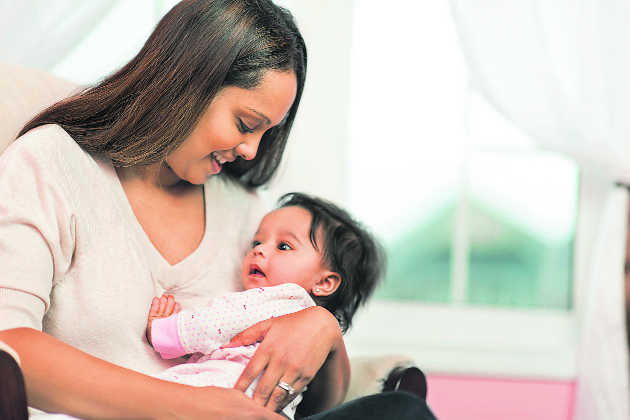Sarika Sharma
A newborn needs no one else as much as it needs its mother. The longer a working mother takes leave, the better it is. With the Rajya Sabha passing the Maternity Benefits Bill, 2016, maternity leave is one step closer to being extended from 12 to 26 weeks in the organised sector. However, how many days do the mother-baby really need together?
The ideal period
The baby has just turned a month old. The mother’s body starts to feel better. The 24-hour sleeplessness ceases to be a shocker and becomes a reality she has to live with for at least one year. That little hand might be curled around your finger, but has the young one cracked that smile when looking at you? And then that first turn, that urge to crawl… The first step is months away… No amount of time with the baby is enough, any mother would say. But, on a practical note, how much is too much. Stressing on the mother-baby bond, Dr Mandar V. Bichu, paediatrician and author of the book Right Parenting: New Age Parenting and Child Health Handbook, says maternity leave of 26 weeks (6 1/2 months) is almost ideal. “These six months of mother’s uninterrupted presence with the baby are important to establish a good breastfeeding pattern and establish a strong mother-child emotional bond.
He says it usually takes six months for a baby to settle down into some sort of a ‘routine’ as far as feeding and sleeping pattern go. “That makes it easier for the person who is going to take care of the baby when the mother joins the office,” Dr Mandar says.
How it helps
A research undertaken by Katharina Staehelin from the University of Basel, Switzerland, showed a positive association between the length of maternity leave and mother’s mental health and duration of breastfeeding. Extended maternity leaves were also associated with lower peri-natal, neonatal and post-neonatal mortality rates as well as lower child mortality.
Researchers have also found that when it comes to maternal employment, there are mostly positive effects such as the higher academic outcomes for children, benefits in their behavioural conduct and social adjustment.
Finally…
Software engineers Sakshi Wadhawan and Nidhi, mother to a two-year-old boy and three-year-old girl, respectively, have been home for just too long. They left jobs, which earned them as much as their husbands, to look after babies. “There was no question of choice. We know men can’t look after babies,” says Nidhi, who was working with a multinational in Delhi, before she shifted base to Mohali after her husband’s transfer.
Sakshi feels the pinch. “My company has told me to join anytime. However, it has been two years and I would have to pick the threads from where I left them. Had I not left job, I would have been the team leader,” she rues and adds, “This field changes so fast. I have been away for almost two years and I was certainly not brushing up my skills at home,” she says.
This is what concerns Deepak Kumar, assistant professor in sociology at Punjabi University, Patiala. He says the Bill fails to depart from the stereotypical notion that babies are women’s responsibilities. “Also, it is important that when a mother is on leave, her promotion and salary are protected. Unless you do that, women start lagging behind and feel demoralised,” he says.
Back to work
Time flies when kids are young. Reorienting is a tough task. Anjana Bhandari, who worked with a newspaper when her second kid was born, shifted gears pretty easily. “It is tough, but, at the end of the day, it is for your kids that you are working,” she says. Her mantra: Try to keep the thoughts about the child away when at work.
Dr Mandar understands. “Pangs of separation are natural and the only way to deal with it is through patience. A good support system will help to overcome these pangs. What the mother must understand is that her decision to go to work is not detrimental or heartless in any way,” he says.
What next?
For Sakshi, going back to work is also about earning her self-respect again. “I am a 24-hour mom, but it pains to see that I am looked down upon as a stay-at-home mother even in my own family.” She hopes to join soon. “I am waiting for my son to join school and then I can get back to work,” she smiles, her two-year-old grinning with his bunny teeth. Nidhi, too, is now looking for a job in Delhi, where her family is from, so that she can get going too, before it is too late.
Around the world
Though the International Labour Organisation recommends at least 14-weeks of paid maternal leave, rules worldwide are different. Sweden and the US are two extremes on this tangent. While the former gives year-long shared parental leave to a couple, world’s most developed economy doesn’t guarantee any. Women rejoin work as early as two weeks after delivery.
Paternity leave debate
There has been a lot of uproar over Woman And Child Welfare Minster Maneka Gandhi’s remark on paternity leave. She said the leave would be a sort of picnic for men. Deepak Kumar, a sociologist from Punjabi University, says it is unfortunate the Bill keeps men out. “They should have been made responsible. The fathers could have been given some time off for child care, not corresponding with the mothers’ leave,” he says.
Unlock Exclusive Insights with The Tribune Premium
Take your experience further with Premium access.
Thought-provoking Opinions, Expert Analysis, In-depth Insights and other Member Only Benefits
Already a Member? Sign In Now










